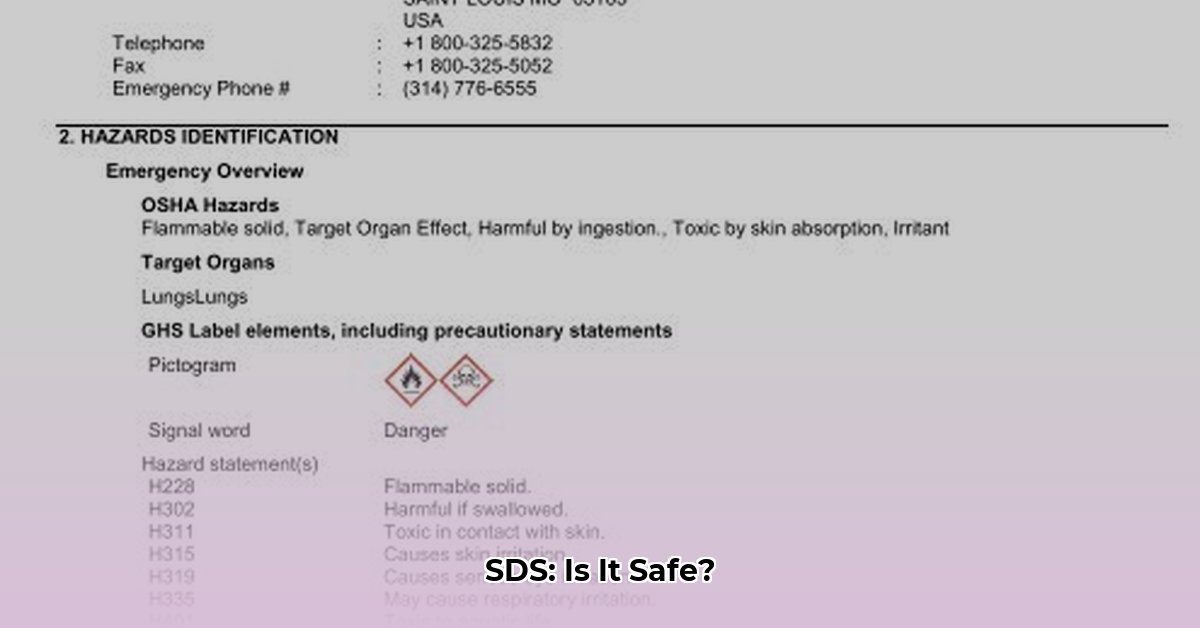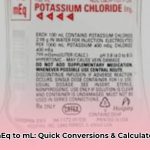This guide provides a detailed explanation of the Safety Data Sheet (SDS), formerly known as MSDS (Material Safety Data Sheet), for sodium dodecyl sulfate (SDS). SDS is a common chemical found in various products, from household cleaners to laboratory reagents. Understanding its potential hazards and safe handling procedures is crucial for anyone who might come into contact with it.
Official SDS Source: Always consult the most up-to-date SDS provided by the manufacturer of the specific SDS product you are using. Many reputable suppliers, such as Sigma-Aldrich, provide SDS documents on their websites.
Quick Safety Overview for SDS
The following table summarizes key hazards, first aid measures, and handling precautions:
| Hazard Summary | Precaution | First Aid |
|---|---|---|
| Skin/Eye Irritation | Wear gloves and eye protection, even when handling household products containing SDS. | Rinse affected area thoroughly with water. Seek medical attention if irritation persists. |
| Respiratory Irritation | Ensure adequate ventilation when using products containing SDS. | Move to fresh air. Seek medical attention if breathing difficulties continue. |
| Harmful if swallowed | Keep products containing SDS out of reach of children. Never ingest. | Rinse mouth. Do not induce vomiting. Seek immediate medical attention. |
| May be harmful to aquatic life | Avoid releasing SDS into the environment. Follow proper disposal guidelines. | N/A |
Understanding the SDS: A Section-by-Section Breakdown
The SDS is organized into sections to provide specific information. Let’s explore each one:
Section 1: Identification
This section provides the essential details about the chemical and the supplier. It includes:
- Product Identifier: The official name of the chemical (Sodium Dodecyl Sulfate or SDS) and any synonyms (e.g., sodium lauryl sulfate, SLS).
- Manufacturer/Supplier Information: The company that manufactured or supplied the SDS, including their address, phone number, and emergency contact information.
- Recommended Use: The intended applications of the SDS.
- Restrictions on Use: Any limitations on the use of the SDS.
Section 2: Hazard(s) Identification
This section details the potential hazards associated with SDS exposure. It includes:
- Signal Word: A word used to indicate the relative level of severity of the hazard, such as “Warning” or “Danger.”
- Hazard Statement(s): Standardized phrases describing the nature of the hazard, such as “Causes skin irritation” or “May cause respiratory irritation.”
- Precautionary Statement(s): Recommended measures to minimize or prevent adverse effects, such as “Wear protective gloves” or “Avoid breathing dust.”
- Hazard Pictogram(s): Graphical symbols that quickly communicate the hazards.
Section 3: Composition/Information on Ingredients
This section lists the ingredients of the product, including:
- Chemical Name(s): The specific chemical names of all components.
- CAS Registry Number(s) (CAS RNs): Unique numerical identifiers assigned to each chemical substance.
- Concentration/Percentage: The amount of each ingredient present in the mixture.
- Impurities: Any other substances present in the product that may pose a hazard.
Section 4: First-Aid Measures
This section provides instructions for immediate first-aid treatment following exposure:
- Inhalation: Steps to take if SDS is inhaled.
- Skin Contact: Steps to take if SDS comes into contact with skin.
- Eye Contact: Steps to take if SDS comes into contact with eyes.
- Ingestion: Steps to take if SDS is swallowed.
- Most important symptoms/effects, acute and delayed: A description of the potential short-term and long-term health effects.
- Indication of any immediate medical attention and special treatment needed: Specific medical treatments that may be required.
Section 5: Fire-Fighting Measures
This section provides information for firefighters and emergency responders:
- Suitable Extinguishing Media: Recommended types of fire extinguishers to use on SDS fires.
- Specific Hazards Arising from the Chemical: Potential dangers that may arise during a fire involving SDS, such as the release of toxic gases.
- Special Protective Equipment and Precautions for Fire-fighters: Safety measures for firefighters, such as wearing appropriate respiratory protection.
Section 6: Accidental Release Measures
This section outlines procedures for containing and cleaning up SDS spills:
- Personal Precautions, Protective Equipment and Emergency Procedures: Safety measures for individuals responding to a spill.
- Environmental Precautions: Steps to prevent environmental contamination.
- Methods and Materials for Containment and Cleaning Up: Specific instructions for cleaning up the spill.
Section 7: Handling and Storage
This section provides guidance on safe handling and storage practices:
- Precautions for Safe Handling: Recommended procedures for handling SDS to minimize the risk of exposure.
- Conditions for Safe Storage, Including Any Incompatibilities: Appropriate storage conditions and incompatible materials to avoid.
Section 8: Exposure Controls/Personal Protection
This section focuses on minimizing exposure to SDS:
- Exposure Limit Values: Recommended limits on the amount of SDS a person can be safely exposed to.
- Appropriate Engineering Controls: Ventilation systems or other engineering measures to reduce exposure.
- Personal Protective Equipment (PPE): Required safety gear, such as gloves, eye protection, and respirators.
Section 9: Physical and Chemical Properties
This section lists the physical and chemical characteristics of SDS:
- Appearance: Physical state (solid, liquid, gas) and color.
- Odor: Description of the smell (if any).
- pH: Acidity or alkalinity.
- Melting Point/Freezing Point: Temperature at which SDS changes from solid to liquid or vice-versa.
- Boiling Point/Initial Boiling Point and Boiling Range: Temperature at which SDS changes from liquid to gas.
- Flash Point: The lowest temperature at which SDS can vaporize to form an ignitable mixture in air.
- Flammability: How easily SDS catches fire.
- Other relevant properties: This may include density, solubility, and viscosity.
Section 10: Stability and Reactivity
This section describes the stability of SDS under various conditions:
- Reactivity: How SDS reacts with other substances.
- Chemical Stability: Conditions that may cause SDS to decompose or become unstable.
- Possibility of Hazardous Reactions: Potential reactions that may produce hazardous byproducts.
- Conditions to Avoid: Specific conditions, such as high temperatures or incompatible materials, that should be avoided.
- Incompatible Materials: Substances that should not be mixed with SDS due to the potential for dangerous reactions.
- Hazardous Decomposition Products: Chemicals produced when SDS breaks down.
Section 11: Toxicological Information
This section details the potential health effects of SDS exposure:
- Information on Likely Routes of Exposure: How a person might be exposed to SDS.
- Symptoms Related to the Physical, Chemical and Toxicological Characteristics: Health effects associated with different types of exposure.
- Delayed and immediate effects as well as chronic effects from short and long-term exposure: Information about the immediate, delayed and chronic effects following SDS exposure.
- Numerical measures of toxicity: Data from toxicity studies, typically conducted on animals.
Section 12: Ecological Information
This section describes the environmental impact of SDS:
- Toxicity: Harmful effects on aquatic organisms and other wildlife.
- Persistence and Degradability: How long SDS persists in the environment and how easily it breaks down.
- Bioaccumulative potential: Whether SDS accumulates in living organisms.
- Mobility in soil: How easily SDS moves through soil.
- Other adverse effects: Any other negative environmental impacts.
Section 13: Disposal Considerations
This section outlines proper disposal methods for SDS:
- Waste Disposal Methods: Recommended procedures for disposing of SDS and contaminated materials.
Section 14: Transport Information
This section provides information on regulations and requirements for transporting SDS:
- UN number: A four-digit code used to identify dangerous goods during transportation.
- UN proper shipping name: The official name used for shipping SDS.
- Transport hazard class(es): The category of hazard SDS poses during transport.
- Packing group: Indicates the degree of danger posed by SDS during transport (I, II, or III).
- Environmental hazards (IMDG Code): Information on whether SDS poses a threat to the marine environment.
- Special precautions which a user needs to be aware of or needs to comply with in connection with transport: Other relevant transport precautions.
Section 15: Regulatory Information
This section lists any specific regulations related to SDS, such as OSHA (Occupational Safety and Health Administration) regulations.
Section 16: Other Information
This section contains any other relevant information not covered in the previous sections.
SDS and You: Applying the Information
Understanding the SDS is essential for safe handling, storage, and disposal of SDS. Always consult the most current SDS provided by the manufacturer of the specific product you’re using. While this guide provides a comprehensive overview, it does not substitute for the specific instructions and precautions outlined in the SDS. Remember, ongoing research continues to refine our understanding of SDS and its potential effects. Staying informed about the latest research and recommendations is the best way to ensure your safety.
- Hydro Extrusions USA Leads North American Aluminum Profile Solutions - December 28, 2025
- Hydro North America Leads Aluminum Extrusion Solutions Across Diverse Industries - December 27, 2025
- Hydro Extrusion North America Provides Custom Solutions Across Diverse - December 26, 2025
















